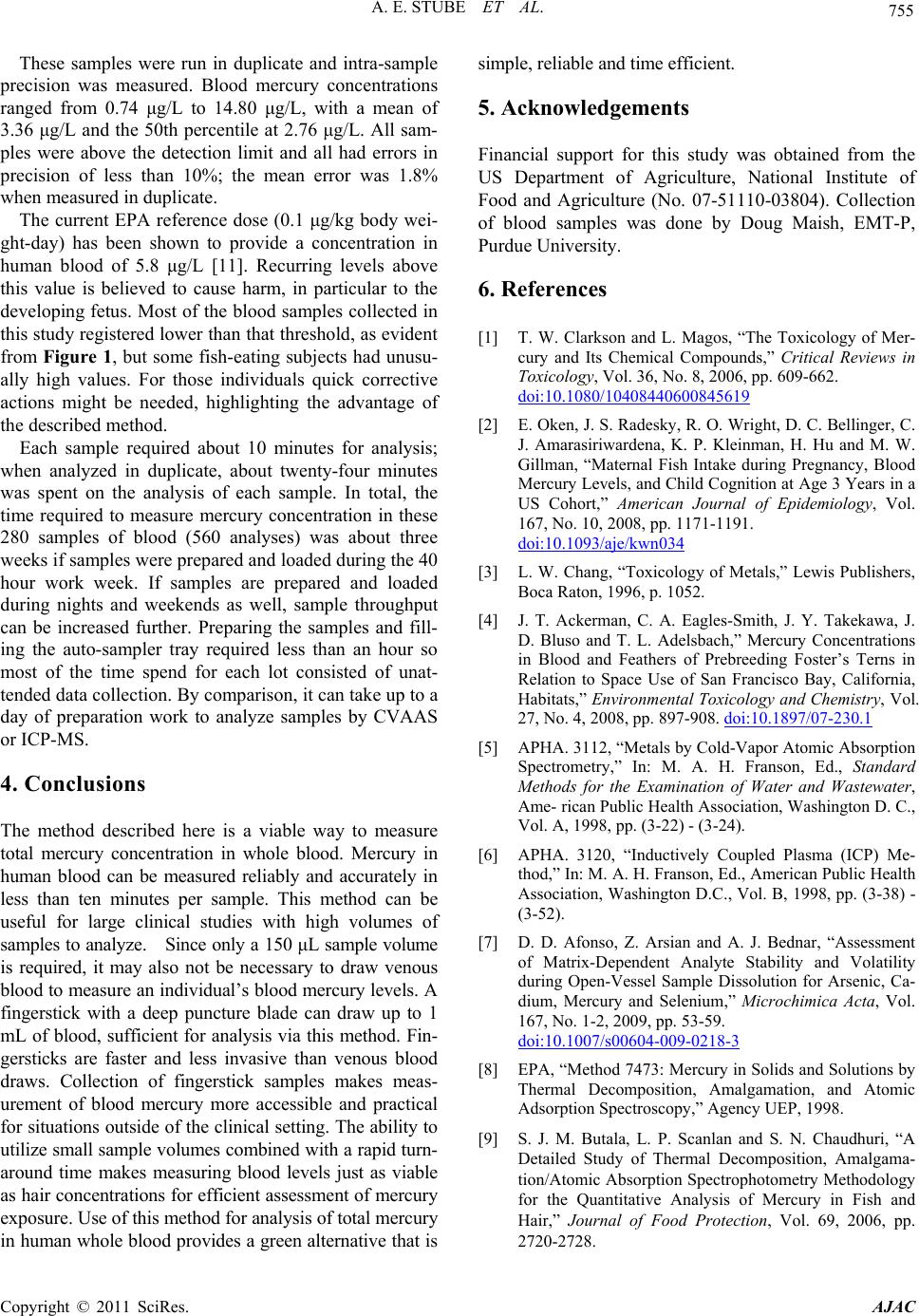
755
A. E. STUBE ET AL.
These samples were run in duplicate and intra-sample
precision was measured. Blood mercury concentrations
ranged from 0.74 μg/L to 14.80 μg/L, with a mean of
3.36 μg/L and the 50th percentile at 2.76 μg/L. All sam-
ples were above the detection limit and all had errors in
precision of less than 10%; the mean error was 1.8%
when measured in duplicate.
The current EPA reference dose (0.1 μg/kg body wei-
ght-day) has been shown to provide a concentration in
human blood of 5.8 μg/L [11]. Recurring levels above
this value is believed to cause harm, in particular to the
developing fetus. Most of the blood samples collected in
this study registered lower than that threshold, as evident
from Figure 1, but some fish-eating subjects had unusu-
ally high values. For those individuals quick corrective
actions might be needed, highlighting the advantage of
the described method.
Each sample required about 10 minutes for analysis;
when analyzed in duplicate, about twenty-four minutes
was spent on the analysis of each sample. In total, the
time required to measure mercury concentration in these
280 samples of blood (560 analyses) was about three
weeks if samples were prepared and loaded during the 40
hour work week. If samples are prepared and loaded
during nights and weekends as well, sample throughput
can be increased further. Preparing the samples and fill-
ing the auto-sampler tray required less than an hour so
most of the time spend for each lot consisted of unat-
tended data collection. By comparison, it can take up to a
day of preparation work to analyze samples by CVAAS
or ICP-MS.
4. Conclusions
The method described here is a viable way to measure
total mercury concentration in whole blood. Mercury in
human blood can be measured reliably and accurately in
less than ten minutes per sample. This method can be
useful for large clinical studies with high volumes of
samples to analyze. Since only a 150 μL sample volume
is required, it may also not be necessary to draw venous
blood to measure an individual’s blood mercury levels. A
fingerstick with a deep puncture blade can draw up to 1
mL of blood, sufficient for analysis via this method. Fin-
gersticks are faster and less invasive than venous blood
draws. Collection of fingerstick samples makes meas-
urement of blood mercury more accessible and practical
for situations outside of the clinical setting. The ability to
utilize small sample volumes combined with a rapid turn-
around time makes measuring blood levels just as viable
as hair concentrations for efficient assessment of mercury
exposure. Use of this method for analysis of total mercury
in human whole blood provides a green alternative that is
simple, reliable and time efficient.
5. Acknowledgements
Financial support for this study was obtained from the
US Department of Agriculture, National Institute of
Food and Agriculture (No. 07-51110-03804). Collection
of blood samples was done by Doug Maish, EMT-P,
Purdue University.
6. References
[1] T. W. Clarkson and L. Magos, “The Toxicology of Mer-
cury and Its Chemical Compounds,” Critical Reviews in
Toxicology, Vol. 36, No. 8, 2006, pp. 609-662.
doi:10.1080/10408440600845619
[2] E. Oken, J. S. Radesky, R. O. Wright, D. C. Bellinger, C.
J. Amarasiriwardena, K. P. Kleinman, H. Hu and M. W.
Gillman, “Maternal Fish Intake during Pregnancy, Blood
Mercury Levels, and Child Cognition at Age 3 Years in a
US Cohort,” American Journal of Epidemiology, Vol.
167, No. 10, 2008, pp. 1171-1191.
doi:10.1093/aje/kwn034
[3] L. W. Chang, “Toxicology of Metals,” Lewis Publishers,
Boca Raton, 1996, p. 1052.
[4] J. T. Ackerman, C. A. Eagles-Smith, J. Y. Takekawa, J.
D. Bluso and T. L. Adelsbach,” Mercury Concentrations
in Blood and Feathers of Prebreeding Foster’s Terns in
Relation to Space Use of San Francisco Bay, California,
Habitats,” Environmental Toxicology and Chemistry, Vol.
27, No. 4, 2008, pp. 897-908. doi:10.1897/07-230.1
[5] APHA. 3112, “Metals by Cold-Vapor Atomic Absorption
Spectrometry,” In: M. A. H. Franson, Ed., Standard
Methods for the Examination of Water and Wastewater,
Ame- rican Public Health Association, Washington D. C.,
Vol. A, 1998, pp. (3-22) - (3-24).
[6] APHA. 3120, “Inductively Coupled Plasma (ICP) Me-
thod,” In: M. A. H. Franson, Ed., American Public Health
Association, Washington D.C., Vol. B, 1998, pp. (3-38) -
(3-52).
[7] D. D. Afonso, Z. Arsian and A. J. Bednar, “Assessment
of Matrix-Dependent Analyte Stability and Volatility
during Open-Vessel Sample Dissolution for Arsenic, Ca-
dium, Mercury and Selenium,” Microchimica Acta, Vol.
167, No. 1-2, 2009, pp. 53-59.
doi:10.1007/s00604-009-0218-3
[8] EPA, “Method 7473: Mercury in Solids and Solutions by
Thermal Decomposition, Amalgamation, and Atomic
Adsorption Spectroscopy,” Agency UEP, 1998.
[9] S. J. M. Butala, L. P. Scanlan and S. N. Chaudhuri, “A
Detailed Study of Thermal Decomposition, Amalgama-
tion/Atomic Absorption Spectrophotometry Methodology
for the Quantitative Analysis of Mercury in Fish and
Hair,” Journal of Food Protection, Vol. 69, 2006, pp.
2720-2728.
Copyright © 2011 SciRes. AJAC